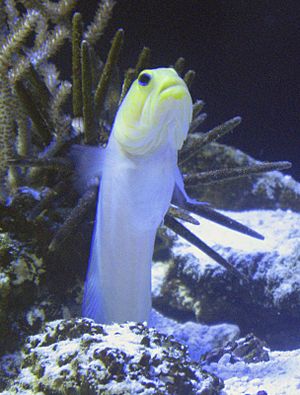Jawfishes facts for kids
Quick facts for kids Jawfishes |
|
|---|---|
 |
|
| Yellow-headed jawfish, Opistognathus aurifrons |
|
| Scientific classification |
|
| Kingdom: | Animalia |
| Phylum: | Chordata |
| Class: | Actinopterygii |
| (unranked): | Ovalentaria |
| Family: | Opistognathidae Bonaparte, 1835 |
Jawfishes are a fascinating group of fish known for their unique way of building homes and caring for their young. These colorful fish belong to a family called Opistognathidae, and there are about 80 different kinds! You can find them in the warm waters of the Atlantic, Pacific, and Indian Oceans, living anywhere from shallow coral reefs to deeper parts of the ocean.
Contents
Meet the Jawfishes!
Jawfishes are small to medium-sized fish. They usually grow to be about 4 to 10 inches (10 to 25 centimeters) long, though some can be smaller or larger. They have big heads and very large mouths, which helps them dig their homes and catch food. Their eyes are also quite large, helping them see in their underwater world. Many jawfish species are brightly colored, with patterns of yellow, blue, green, or brown, helping them blend in with their surroundings or stand out to attract a mate.
Where Jawfishes Live
Jawfishes prefer to live in warm, tropical, and subtropical waters. You can find them in the Atlantic Ocean, including the Caribbean Sea, as well as across the vast Pacific and Indian Oceans. They live on the seafloor, often in areas with sand, rubble, or small rocks. While some jawfishes live in very shallow waters, close to coral reefs, others can be found much deeper, sometimes hundreds of feet below the surface. Each species has its favorite depth and type of seafloor.
Amazing Jawfish Homes
One of the most interesting things about jawfishes is how they build their homes. They are expert diggers! Using their large mouths and strong bodies, they dig burrows in the sand or rubble. These burrows are like little tunnels or caves that provide a safe place to hide from predators and rest.
Jawfishes often line the inside of their burrows with small stones, pieces of shell, or other debris they find on the seafloor. This helps to strengthen the walls of their home and keep it from collapsing. They spend most of their time near the entrance of their burrow, ready to dart inside if danger approaches. If they feel threatened, they can quickly disappear headfirst into their safe haven.
What Jawfishes Eat
Jawfishes are carnivores, meaning they eat other small animals. They are often ambush predators, waiting patiently at the entrance of their burrow for food to pass by. Their diet mainly consists of small invertebrates, which are tiny animals without backbones, like small crustaceans (such as tiny crabs or shrimp) and worms. They also eat zooplankton, which are microscopic animals that drift in the water currents. When a tasty meal swims close enough, the jawfish quickly darts out of its burrow to snatch it with its big mouth.
Jawfish Families: A Special Way to Care for Babies
Jawfishes have a very unique way of raising their young, called mouthbrooding. After the female jawfish lays her eggs, the male jawfish collects them and holds them safely inside his mouth. He carries the eggs around in his mouth until they hatch, which can take several days or even weeks, depending on the species.
During this time, the male jawfish cannot eat much, if at all, because his mouth is full of eggs. He protects the eggs from predators and keeps them clean by gently rolling them around. Once the baby jawfishes, called larvae, hatch from the eggs, they are released into the water to begin their lives. This special parenting method helps to keep the vulnerable eggs safe until they are ready to swim on their own.
See also
 In Spanish: Bocones para niños
In Spanish: Bocones para niños

